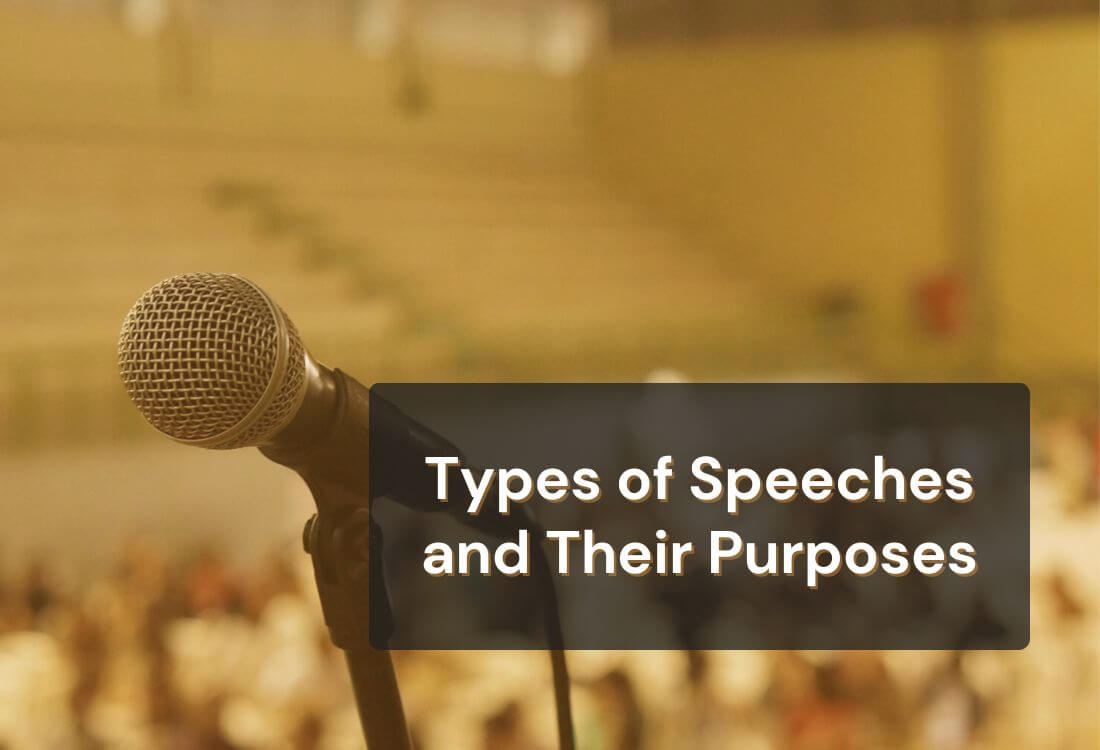



Public speaking is an important skill that helps people share ideas, influence opinions, and inspire action. Choosing the appropriate speech format for any situation is vital for delivering a clear message, and your success depends on understanding the various types of speeches and their specific purposes.
Each style has a unique role in effective communication, from informative speeches that explain complex topics to motivational speeches that encourage action. Tailoring speeches to your audience will improve your confidence and make you a more adaptable speaker.

Informative speeches focus on educating the audience about a specific subject in a clear and structured way. The purpose of this type of speech is to present knowledge that the audience can easily understand and apply. Classrooms, company meetings, and community presentations widely use these kinds of speeches because they simplify complex topics and make information accessible.
Examples:
Key Elements:
Tip: When preparing an informative speech, aim to simplify complex ideas and present them in steps the audience can follow. Use informative speech examples drawn from everyday life, statistics, or case studies to make abstract concepts easier to grasp. This kind of speech works best when paired with stories or scenarios your audience can relate to.
For a deeper breakdown, see the full guide to types of informative speeches.
Persuasive speeches are designed to convince an audience to embrace a viewpoint or take specific action. Unlike informative speeches, which focus on sharing knowledge, this type of speech seeks to influence beliefs, attitudes, or behaviors. Effective persuasive speech writing blends logic, credibility, and emotional appeal, making it one of the most powerful forms of public speaking.
Examples:
Techniques:
Tip: When delivering this type of speech, focus on your audience’s values and motivations. Tailor your message to their needs, and use proven persuasive techniques to make your argument resonate. The more relevant your points, the better chance you have of inspiring action.
Demonstrative speeches are instructional in nature and show the audience how to complete a task through clear, step-by-step guidance. The goal of this type of speech is to make a process easy to understand and repeat. This form of speech is widely used in classrooms, workshops, and training sessions, where visual aids and hands-on examples play a key role in enhancing learning.
Examples:
Key Aspects:
Tip: Incorporate visual aids to strengthen your demonstrative speech. Props, charts, or live examples illustrate steps more clearly, making it easier for the audience to understand and replicate the task.
Oratorical speeches are formal presentations delivered with eloquence, powerful rhetoric, and a commanding style. This type of speech is often reserved for historic or ceremonial events, such as inaugurations, commemorations, or national celebrations. The speaker’s goal is to inspire and captivate the audience through carefully chosen words, strong presence, and purposeful delivery. Among the different types of speeches, oratorical addresses stand out for their grandeur and ability to unify audiences.
Examples:
Key Elements:
Tip: To deliver an impactful oratorical speech, practice with emotion and conviction. Use body language, vocal variety, and eye contact to connect with listeners and leave a lasting impression. Among the different categories of speeches, oratorical presentations often rely on the speaker’s passion as much as the words themselves.”

Motivational speeches aim to inspire audiences to take action, embrace change, or improve their lives. This type of speech often draws on personal stories, lessons learned, or examples of resilience to encourage listeners. Among the different kinds of speeches, motivational talks stand out because they combine emotional connection with practical guidance that people can apply immediately.
Examples:
Key Elements:
Tip: When preparing a motivational speech, focus on authenticity. Genuine stories resonate more deeply than generic advice. Choose topics that align with your experiences and provide audiences with practical steps they can implement right away.

Entertaining speeches focus on amusing and engaging the audience through humor, storytelling, or lighthearted anecdotes. It is usually delivered in informal settings where the main goal is enjoyment rather than persuasion or education. Unlike others, entertaining talks emphasize connection and atmosphere over structure and formality.
Examples:
Key Elements:
Tip: To deliver a successful entertaining speech, keep the tone relaxed and relatable. Match your stories and humor to the audience’s mood and interests, ensuring your talk feels natural and well-suited to the occasion.
Special occasion speeches are designed to honor a person, milestone, or event. These speeches are common at award ceremonies, weddings, anniversaries, and other important gatherings. The tone of a special occasion speech can range from humorous to heartfelt, depending on the event and the relationship between the speaker and the audience. The purpose here is less about informing or persuading and more about celebrating and creating a memorable moment.
Examples:
How to Deliver Special Occasion Speeches:
Tip: When preparing a special occasion speech, focus on emotions that fit the event’s atmosphere. Share personal stories that highlight the meaning of the celebration, and keep the tone aligned with the occasion. This approach ensures your speech feels genuine and leaves a lasting impression.
Impromptu speeches are delivered without prior preparation and rely on quick thinking. This type of speech is common in spontaneous situations such as Q&A sessions, volunteer events, or community gatherings. Impromptu talks test your ability to organize thoughts quickly and communicate clearly under pressure.”
Examples:
Tips for Delivering Impromptu Speeches:
Tip: Regular practice builds confidence for impromptu speeches. To prepare for moments when you need to think quickly, try using mock scenarios, random prompts, or timed exercises. These impromptu speaking tips help improve clarity and reduce hesitation.
Choosing the right type of speech depends on three key factors: audience, purpose, and context. It's essential to analyze these factors before deciding on the speech format:
Examples of Blending Speech Types:
Once you’ve chosen the right type of speech, the next step is deciding how to deliver it. Learn more about the methods of speech delivery that match your style with your message.
When delivering a speech, especially in a formal setting or a high-stakes event, using a teleprompter can be a great tool for maintaining a smooth and engaging presentation. A teleprompter displays the speech text on a transparent screen, positioned in front of the speaker, ensuring that they maintain eye contact with the audience while following their script. This technique is widely used across various types of speeches, from informative speeches in business presentations to motivational speeches at large events.
Enhance your next speech with the confidence and professionalism that a teleprompter provides. Sign up with Teleprompter.com and experience the difference in your delivery.
Understanding the different types of speech can greatly improve your public speaking skills. Informative speeches educate, while persuasive speeches inspire action. Each type has a unique role in effective communication. Practice these types regularly, and feel free to experiment with combining different styles to fit your needs. By refining your skills in various speech types, you will become a more versatile and confident speaker who can engage any audience.
The main types of speeches include informative, persuasive, demonstrative, oratorical, motivational, entertaining, special occasion, and impromptu speeches. Each serves a unique purpose, ranging from educating or persuading to inspiring or entertaining audiences during formal and informal events.
An effective persuasive speech combines strong evidence, emotional appeal, and confident delivery. It connects to the audience’s values while presenting logical arguments supported by credible data, encouraging listeners to adopt a belief or take action.
Impromptu speeches help speakers think on their feet and organize ideas quickly. Regular practice builds confidence, spontaneity, and clarity—skills that improve overall public speaking performance across different speaking environments.
A demonstrative speech teaches the audience how to perform a task or process through step-by-step instruction. It’s commonly used in training sessions, cooking classes, or workshops where visual aids and clear explanations enhance understanding.
A teleprompter allows speakers to maintain eye contact with the audience while reading their script. It supports smoother delivery, better pacing, and increased confidence—especially useful for formal presentations, motivational talks, or virtual events.



